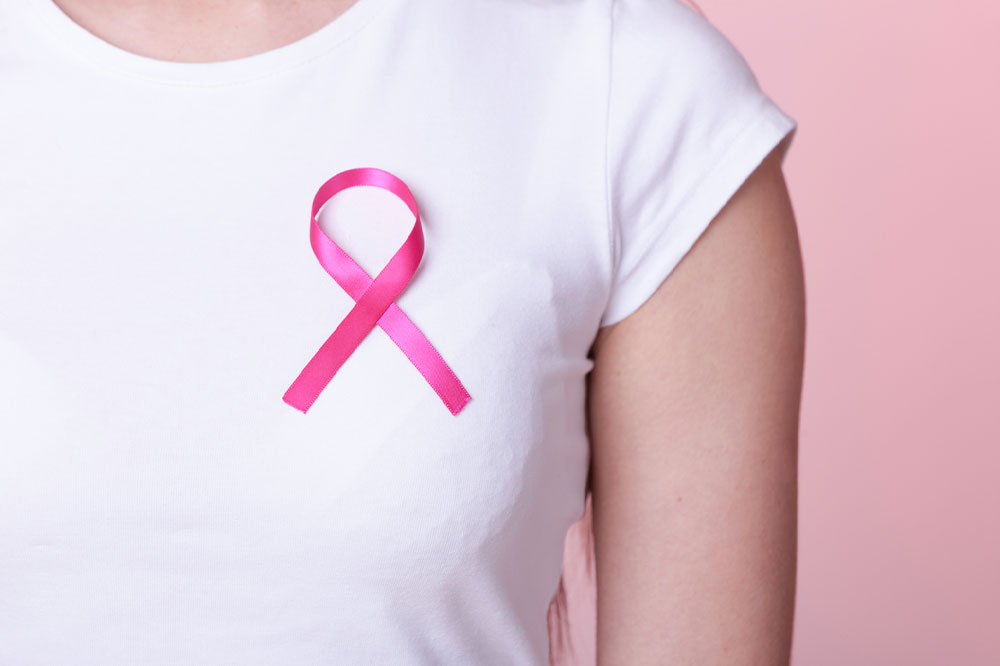Breast cancer – Causes, Types, and Prevention

Breast cancer is a cancer that occurs in the cells of the breast. There are several types of breast cancer, and the kind depends on which cells in the breast turn malignant. After skin cancer, breast cancer is the second most diagnosed cancer in women in the country. However, breast cancer can occur in women as well as men, but is more common in women. Read on to learn more about breast cancer.
Symptoms
A lump or mass that feels as small as a pea
Change in the contour, shape, or size of the breast
Marble-like hardened area underneath the skin
Redness of the skin on the nipple or breast
Change in the feel or look of the skin on the nipple or breast
A thickening or lump in or near the breast or in the underarm, which persists through the menstrual cycle
Clear fluid discharge or blood-stain from the nipple
The area looks distinctly different from other areas on the breast
Newly inverted nipple
Some people might not notice any breast cancer signs, so it is vital to undergo routine mammograms.
Causes
The precise cause for breast cancer is unknown. However, sometimes it is inherited. It is known as hereditary breast cancer. In addition, some genetic changes also aggravate the risks, such as changes in the BRCA2 and BRCA1 genes. These also put one at risk of ovarian and other cancers. Beyond lifestyle and genetics, the environment may heighten one’s susceptibility.
Risk factors
Being female: Women are more likely to develop breast cancer than males.
Age: The risk of breast cancer amplifies with age.
Personal history of breast cancer: If one has had breast cancer in one of the breasts, one may develop it in the other breast.
Personal history of breast conditions: If one has undergone a breast biopsy that detected atypical hyperplasia of the breast or carcinoma in situ, one’s chances of developing breast cancer are high.
Having never been pregnant: Women who never got pregnant have a higher risk of developing breast cancer than women who have had one or more pregnancies.
Family history of breast cancer: If a person’s daughter, sister, or mother has had breast cancer, especially at a younger age, one’s risk also amplifies.
Inherited genes: Some gene mutations can also make one susceptible to breast cancer, which may be passed from parents to children. These mutations are called the BRCA1 and BRCA2 and aggravate the risk of developing breast or other cancers.
Early beginning of menstrual cycles: Early beginning of menstrual cycles also puts one at risk of breast cancer.
Radiation exposure: If one underwent radiation treatment on the chest as a young adult or a child, one is susceptible to breast cancer.
Bearing the first child at an older age: Women who reproduce after thirty are prone to developing breast cancer.
Starting menopause at an older age: If one’s menopause commences at an older age, the risk for breast cancer increases.
Postmenopausal hormone therapy: Women who take hormone therapy that combines progesterone and estrogen to cure menopause signs also are susceptible to breast cancer.
Types
In situ cancers
These cancers do not spread past the lobule or duct where they start. These include:
Lobular carcinoma in situ: It is present strictly in the lobules that yield breast milk. It is not real breast cancer but implies a greater risk of later developing it. Thus, doctors advise routine mammograms and breast examinations.
Ductal carcinoma in situ: It is stage zero cancer, wherein the cancer is still in the milk ducts. It is curable but may become invasive if no measures are taken to treat it.
Invasive cancers
Invasive cancers have invaded or spread around the surrounding breast tissue. These include:
Infiltrating or invasive ductal carcinoma : It commences in the milk ducts and breaks through the duct walls to invade the breast’s fatty tissue. It is the most common type of breast cancer and accounts for eight percent of invasive cases.
Invasive lobular carcinoma
It commences in the lobules but travels to the tissues or the other body parts. These include ten percent of all invasive breast cancers. Some of its subtypes include:
Adenoid cystic carcinoma : These resemble the cells in the saliva or the salivary glands.
Tubular carcinoma: They are slow-growing, tube-shaped tumors.
Mucinous carcinoma: It is a rare type wherein the tumors float in the mucin pool, a part of the slimy, slippery stuff that makes up the mucus.
Low-grade adenosquamous carcinoma: It is a rare, metaplastic, slow-growing tumor, usually mistaken for other cancer types.
Papillary carcinoma: Their finger-like projections set them apart and are common in women who have undergone menopause.
Medullary carcinoma: They are a rare type and form a squishy mass resembling the medulla in the brain.
Some less common types include:
Metastatic breast cancer: Here, cancer spreads to other body parts like the lungs, bones, or the brain.
Inflammatory breast cancer: It is rare from the inflammatory cells in the lymph vessels in one’s skin.
Phyllode tumors: It has a leaf-like pattern, and these rare tumors grow rapidly but rarely spread beyond the breast.
Paget’s nipple disease: It affects the areola or the skin surrounding the nipple.
Preventive measures
A few lifestyle changes may lower one’s risk of developing breast cancer. These include:
Being physically active
Get at least 75 minutes of vigorous aerobic workout or 150 minutes of moderate aerobic activity every week. In addition, one must also indulge in strength training twice a week.
Breastfeeding
Studies suggest the longer one breastfeeds one’s child, the greater its preventive ability.
Curtail postmenopausal hormone therapy
Consult a medical healthcare expert about the benefits and risks associated with hormone therapy. At times, it is possible to monitor the symptoms with non-hormonal therapies. Hence, if the short-term hormone therapy benefits outweigh its risks, one can continue using them in the lowest dose possible.
Avoid birth control pills after 35
Birth control has benefits and risks. Women who take these pills are at an increased risk of developing breast cancer, but the susceptibility lowers once the pills are stopped.



